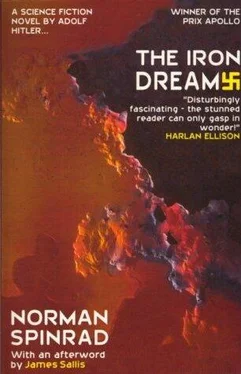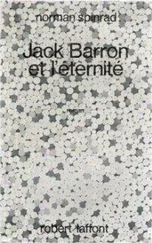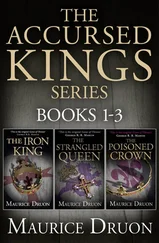Norman Spinrad - The Iron Dream
Здесь есть возможность читать онлайн «Norman Spinrad - The Iron Dream» весь текст электронной книги совершенно бесплатно (целиком полную версию без сокращений). В некоторых случаях можно слушать аудио, скачать через торрент в формате fb2 и присутствует краткое содержание. Год выпуска: 1999, ISBN: 1999, Издательство: Toxic, Жанр: Фантастика и фэнтези, на английском языке. Описание произведения, (предисловие) а так же отзывы посетителей доступны на портале библиотеки ЛибКат.
- Название:The Iron Dream
- Автор:
- Издательство:Toxic
- Жанр:
- Год:1999
- ISBN:1-902002-16-4
- Рейтинг книги:4 / 5. Голосов: 1
-
Избранное:Добавить в избранное
- Отзывы:
-
Ваша оценка:
- 80
- 1
- 2
- 3
- 4
- 5
The Iron Dream: краткое содержание, описание и аннотация
Предлагаем к чтению аннотацию, описание, краткое содержание или предисловие (зависит от того, что написал сам автор книги «The Iron Dream»). Если вы не нашли необходимую информацию о книге — напишите в комментариях, мы постараемся отыскать её.
Lord of the Swastika
The Iron Dream — читать онлайн бесплатно полную книгу (весь текст) целиком
Ниже представлен текст книги, разбитый по страницам. Система сохранения места последней прочитанной страницы, позволяет с удобством читать онлайн бесплатно книгу «The Iron Dream», без необходимости каждый раз заново искать на чём Вы остановились. Поставьте закладку, и сможете в любой момент перейти на страницу, на которой закончили чтение.
Интервал:
Закладка:
Since this phallic sexuality of violence and military pageantry is a common transference in western society, the book gains great power by keying itself into one of the most prevalent sexual pathologies of our civilization.
What is open to dispute is whether or not Hitler was consciously aware of what he was doing.
Those who would claim that Hitler employed his systematic phallic imagery as a consciously calculated device can rightly claim that its consistent application points toward an act of self-conscious creation. Further, Hitler displays a cogent understanding of how visual symbols and events may be used to manipulate the mass psyche. One can believe that the mass torchlight rallies he describes in the book would in fact inflame the passions of real mobs hi a manner roughly akin to what takes place in the novel.
The adoption of the swastika colors by groups in our own society is additional evidence that Hitler knew full well how to devise visual images capable of having a powerful effect upon the viewer. Thus, by extension, it becomes superflcially reasonable to suppose that Hitler deliberately invested Lord of the Swastika with phallic imagery in order to capture the rapt attention of the unsophisticated.
A cursory study of commercial science fantasy would seem to confirm this contention. The hero with the magical sword is a common, indeed virtually universal, feature of so-called sword and sorcery novels. Such novels are written according to a simple formula whereby this super-masculine figure, aided by his unusually potent weapon, with which he has an obvious phallic identification, overcomes great obstacles to gain his inevitable triumph. Hitler was active in the microcosm of “science-fiction random” for decades, and in fact many such fantasies were reviewed in his own fanzine. It is therefore reasonable to assume that he was quite familiar with the genre; in fact two or three of his earlier novels approached the sword-and-sorcery vein.
Lord of the Swastika is at least schematically a typical pulp sword-and-sorcery novel. The hero (Jaggar) receives the phallic weapon as a symbol of his rightful supremacy and then triumphantly fights his way through a series of gory battles to final victory. Aside from the political allegory and the more specialized pathologies which I will deal with later, it is the obsessional consistency and intensity of the phallic symbolism which distinguishes Lord of the Swastika from a host of similar science-fantasy novels.
This leads to the conclusion that Hitler made a straightforward study of the nature of the appeal of the sword-and-sorcery genre, and self-consciously increased the pathological appeal of his own book beyond the ordinary by strengthening the phallic symbolism and making it that much more blatant and pervasive. This would make Lord of the Swastika a cynical exploitation of sexual pathology quite common to this genre, though of such a thorough-going nature that its power far exceeds that of its more timid models.
However, I believe that this theory may be disproved both by internal evidence within the novel and by the nature of the science-fiction genre itself.
For one thing. Lord of the Swastika displays abundant evidence of mental aberration on the part of its author quite aside from the question of phallic symbolism. The fetishism which permeates the novel could hardly be consciously designed to appeal to the average unsophisticated reader. Throughout the book, an obsessive amount of attention is paid to uniforms, especially the tight black leather uniforms of the SS. The frequent conjunction of repetitious description of “shiny black leather,” “gleaming chrome,” “high-steel-soled boots,” and similar articles of clothing and adornment with phallic gestures such as the
Party salute, heel clicking, precision marching, and the like is dear indication of unselfconscious fetishism on the part of Hitler of a particularly morbid sort, hardly likely to appeal to any but the most thoroughly disturbed personality.
Indeed, in the book Hitler seems to assume that masses of men in fetishistic uniforms marching in precise displays and displaying phallic gestures and paraphernalia will have a powerful appeal to ordinary human beings. Feric Jaggar comes to power in Heldon through little more than a grotesque series of increasingly grandiose phallic displays.
This is undoubtedly phallic fetishism on the part of the author, since the alternative conclusion is to accept the ridiculous notion that an entire nation would throw itself at the feet of a leader simply on the basis of mass displays of public fetishism, orgies of blatant phallic symbolism, and mass rallies enlivened with torchlight and rabid oratory. Obviously, such a mass national psychosis could never occur in the real world; Hitler’s assumption that it not only could happen but would be an expression of so-called racial will proves that he himself was suffering from such a malady.
Beyond the fetishism, the novel displays internal inconsistencies even on the gross level of commercial science fiction that are sure indications that the author’s contact with reality faded more and more as he became involved with his own obsessions while writing what no doubt started out as simply another commercial potboiler.
The novel opens in a world where the highest technology is represented by the steam engine and the crude flying machine and progresses in a ridiculously short stretch of fictional time through television, machine guns, modem tanks, jet fighters, artificially grown human beings, and finally an interstellar spaceship. Hitler makes no attempt whatever to justify any of this; it is wish-fulfillment from beginning to end. Admittedly, unjustified and inconsistent wish-fulfillment fantasies are common in low-grade science fiction, but hardly to this ludicrously obvious extent. Hitler seems to assume that the very existence of a hero like Feric Jaggar would call into being these quantum-jumps in science and technology. Given the close author identification with a hero of this sort, this is a symptom of the grossest narcissism.
Perhaps even more pathological are Hitler’s secretional and fecal obsessions. “Foul odors,” “pestilences,” “reeking sties,” “fetid cesspools,” and the like abound in the book.
Again and again. Hitler displays his morbid dread of body secretions and processes. He is forever describing the hated Zind Warriors as “drooling,” “defecating,” “urinating,” and so forth. Monsters are covered with slime clearly reminiscent of nasal mucous. The forces of evil are described in terms of noxious secretions, filth, foul odors and excretions, whereas the forces of good are “spotless,” “gleaming,” and “precise,” their equipment and persons having shiny surfaces burnished to sterile glosses. The anality of this dichotomy should be clear even to the layman.
The violence in the book verges on the psychotic. Hitler describes the most ghastly slaughters as if he not only finds them attractive but assumes that his readers will be likewise enthralled. There is no doubt that the treatment of violence in Lord of the Swastika adds a special morbid appeal to the book. Here the reader is treated, if that is the word, to something that may be unique in all literature: the most ghastly, perverse, and loathsome violence described by a writer who obviously intends such hideous spectacles to be edifying, uplifting, and even expressions of nobility. De Sade himself did not go so far, for his horrors are at worst meant to be sexually titillating, whereas Hitler equates mass destruction, ruthless slaughter, nauseating violent excesses, and genocide with pious self-righteousness, honor and virtue, and, moreover, writes as if he fully expects the average reader to share his point of view as self-evident truth. Surely this is clinching evidence that the power of Lord of the Swastika lies not in the skill of the writer but in the unbridled pathological fantasies which he has unselfconsciously committed to print.
Читать дальшеИнтервал:
Закладка:
Похожие книги на «The Iron Dream»
Представляем Вашему вниманию похожие книги на «The Iron Dream» списком для выбора. Мы отобрали схожую по названию и смыслу литературу в надежде предоставить читателям больше вариантов отыскать новые, интересные, ещё непрочитанные произведения.
Обсуждение, отзывы о книге «The Iron Dream» и просто собственные мнения читателей. Оставьте ваши комментарии, напишите, что Вы думаете о произведении, его смысле или главных героях. Укажите что конкретно понравилось, а что нет, и почему Вы так считаете.












